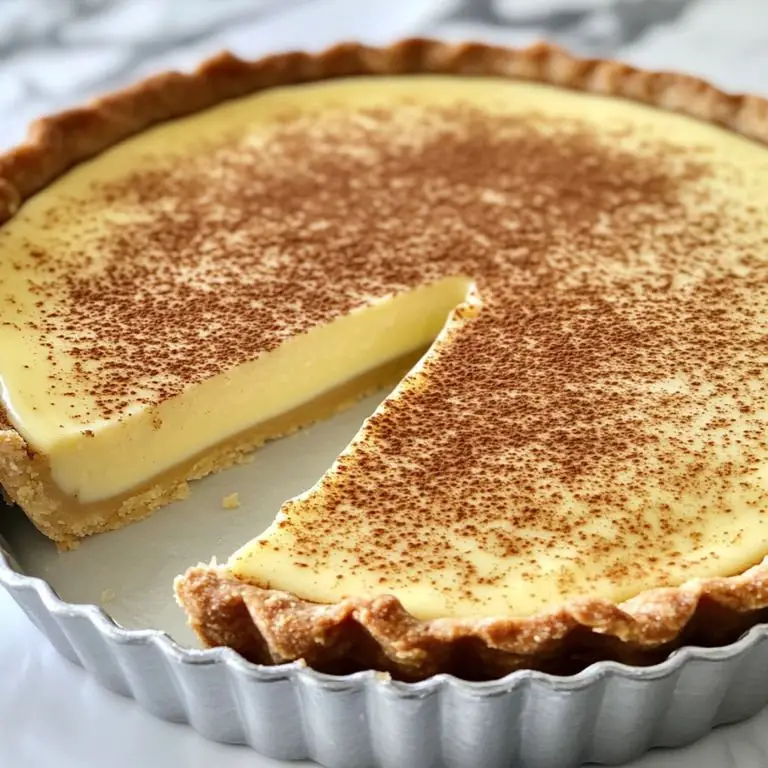
South African milk tart, or "melktert," is a creamy, cinnamon-dusted custard tart that’s been a staple in South African food culture for generations. Unlike traditional custard pies, this version is lighter and delicately sweet, thanks to a luscious milk-based filling set in a crisp, buttery crust. It’s the perfect teatime treat or dessert for any gathering, making it one of the most beloved South African desserts.
The crust of a milk tart plays a subtle yet crucial role in balancing the creamy filling with a crisp, buttery texture. A homemade crust allows you to control sweetness, texture, and overall quality. With ingredients like cold butter, sugar, and flour, you create a base that’s both flaky and flavorful. The process of rubbing butter into flour and gently adding water may be slightly more time-consuming, but the result is well worth it.
On the other hand, store-bought shortcrust pastry can be a lifesaver for busy bakers. It offers consistency and cuts down on prep time. While it may lack the nuanced richness of a from-scratch version, it's still a reliable option—especially when blind-baked properly to prevent sogginess. Whether you go the homemade route or opt for convenience, the key is a fully baked crust that holds its shape and provides a satisfying contrast to the soft custard.
The soul of a milk tart is its luscious custard—light, creamy, and delicately flavored with cinnamon and vanilla. To achieve a smooth, lump-free consistency, start by whisking the eggs, sugar, cornstarch, and flour thoroughly before adding any liquid. This dry mixture acts as your custard’s thickening agent and must be fully incorporated to prevent clumping.
Tempering the egg mixture with warm milk is essential. Pour the hot milk slowly into the egg mixture while whisking continuously to avoid cooking the eggs too quickly. Once combined, return the mixture to the heat and cook on low, stirring constantly with a wooden spoon or silicone spatula. Pay attention to the bottom of the pot, where custard tends to catch and burn.
For extra insurance against lumps, you can strain the finished custard through a fine-mesh sieve before pouring it into the tart shell. The result is a silky filling that sets beautifully in the fridge, with a texture that practically melts in your mouth.
A slice of this milk tart pairs beautifully with a cup of rooibos tea or a freshly brewed espresso. For a South African-inspired dessert spread, serve it alongside koeksisters (syrup-dipped pastries) or buttery rusks.
Milk tart is an ideal make-ahead dessert. The custard needs time to set, which means the flavor and texture actually improve after a few hours in the refrigerator. You can prepare the tart a day in advance, letting it chill overnight for best results.
When it comes to storing leftovers, cover the tart tightly with plastic wrap or store slices in an airtight container. It will stay fresh in the refrigerator for up to 4 days. Avoid storing it uncovered, as the custard can absorb fridge odors and the surface may dry out.
Freezing milk tart isn’t generally recommended due to the custard's high milk content, which may separate or become grainy when thawed. However, if you must freeze it, wrap it tightly and consume within a month. Let it thaw in the refrigerator overnight before serving.
While traditional melktert is beloved for its simplicity, there's room to play with flavors for a modern twist. Here are a few variations to explore:
These adaptations allow you to customize the milk tart while keeping its essence intact—light, creamy, and comforting.
Even a seemingly simple dessert like melktert can run into pitfalls. Here are a few common mistakes and how to avoid them:
Mind these details, and you’ll ensure a perfect milk tart every time—smooth, set, and delicious.
If you're entertaining or want a portable version of this dessert, consider making mini melkterts or tart bars. For mini tarts, use a muffin tin lined with small rounds of pastry dough. Blind-bake the crusts, then fill each with custard and chill as usual. They're adorable, convenient, and ideal for buffets or afternoon teas.
To make milk tart bars, press the crust into a rectangular baking dish lined with parchment paper. After baking the crust and adding the custard, allow the entire slab to chill, then slice into squares. Bars are easier to portion and perfect for bake sales, picnics, or lunchbox treats.
Regardless of the format, reduce baking and chilling times slightly and be sure to adjust crust thickness for smaller formats to avoid overpowering the filling.
For those with dietary restrictions, melktert can be modified without sacrificing too much of its charm. To make a dairy-free version, use full-fat oat milk or almond milk and substitute the butter with vegan margarine or coconut oil. Coconut milk adds richness but will infuse a noticeable flavor—great for those who enjoy it.
For a gluten-free crust, replace the all-purpose flour with a gluten-free flour blend that includes xanthan gum for structure. Alternatively, make a crust using almond flour, coconut flour, or even crushed gluten-free cookies bound with butter.
You can also explore egg-free alternatives by using custard powder or cornstarch thickened with a plant-based milk. The consistency won’t be identical, but it will still yield a creamy, sliceable dessert that captures the essence of milk tart.
Unlike French-style custard tarts, melktert has a higher milk-to-egg ratio, making it lighter and creamier.
Yes! A ready-made shortcrust pastry works well if you’re short on time.
Whole milk is ideal for a rich texture, but you can substitute half-and-half for extra creaminess.